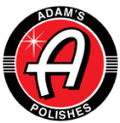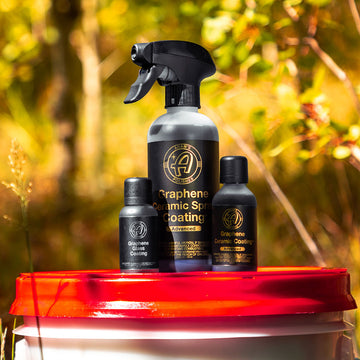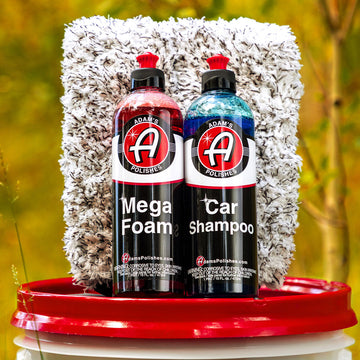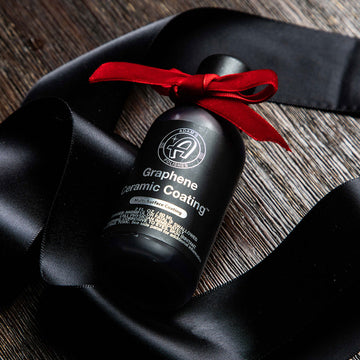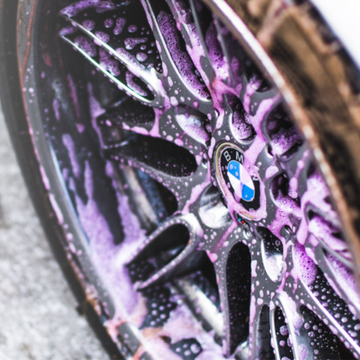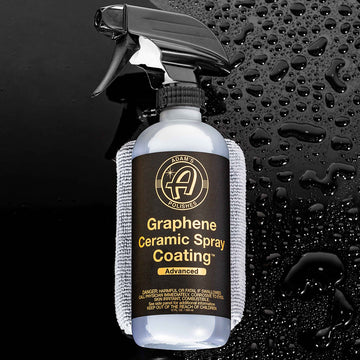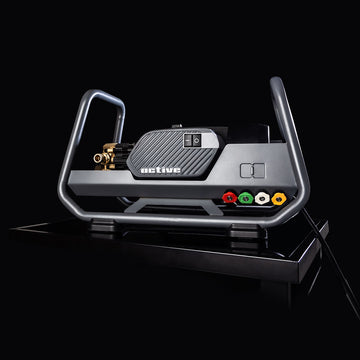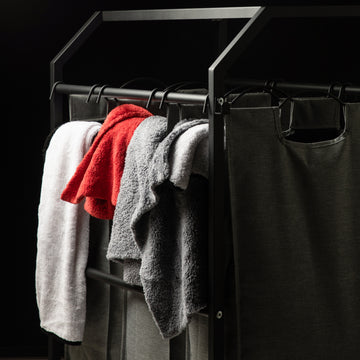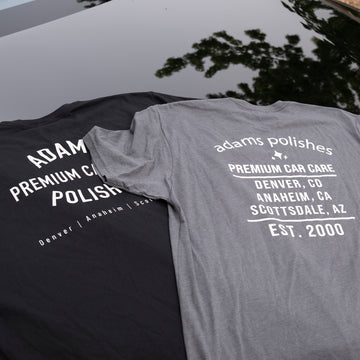The next category in protection tech are synthetic sealants. Sealants are chemist made acrylics and resins, rather than having natural waxes as a base. They are applied in a similar manner to wax - in a thin and even layer onto the vehicle surface. After allowing the sealant to haze for a few minutes, the residue is buffed off to a shine with a premium microfiber towel.
Sealants like our Paint Sealant are the next step up from wax in terms of durability, strength, and protection. Using thermo-resins, Paint Sealant has a higher resistance to extreme temperatures, making it a better option than wax for vehicles that are frequently parked outside. Glass Sealant is specifically formulated to make the windshield and other exterior glass extremely hydrophobic, or water-repelling, for several hundred miles of rain driving per application. Rainwater and snow will bead and repel themselves off of your windshield at highway speeds, keeping your glass clean and ensuring that you still have a good view of the road during stressful and more dangerous driving conditions. And rounding out our sealant category is Tire Armor, a durable tire dressing designed to keep tires protected for several months at a time.
Paint Sealant
Adam’s Paint Sealant has gone through a few evolutions throughout the years - from Machine Super Sealant to Liquid Paint Sealant to now simply just Paint Sealant. The original version more than 10 years ago wasn’t the easiest to work with, requiring a fair amount of effort to remove, then a 24-hour cure time, and then wiping the surface again after the cure period. Chemistry advancements have allowed it to become much easier to use, with the current version going on much more like a traditional cream wax but providing 6 months or more of protection in most applications. The UV blockers in the formula carefully maintain the gloss, shine, and reflective properties of your vehicle’s finish even when left out in direct sunlight for prolonged time periods.
The unique blend of polish agents and acrylic polymer resins in Paint Sealant make it easy to remove and leave behind a brilliant finish. This formulation provides a durable protective layer to any painted surface and is built to withstand the harshest seasons and elements. Paint Sealant has strong hydrophobic behavior. It fills in and bonds to the microscopic peaks and valleys of painted surfaces, reducing surface tension and letting water roll right off. Adam’s Paint Sealant can be applied by hand with a Grey Microfiber Applicator Pad or by machine with our Red Foam Wax & Sealant Pad, and should be applied before waxes or glazes to ensure a strong bond with the clear coat surface. During application, this product thinly spreads out across the surface and sets up within 3-5 minutes before removal with a plush microfiber towel.
Glass Sealant
It’s just as important to have clear and protected glass as it is paint, and this is where Glass Sealant steps in. Our Glass Sealant is a highly-concentrated liquid sealant that leaves glass surfaces incredibly slick and hydrophobic. After glass is treated, rainwater will begin to dance and push itself from the glass starting at around 30-40mph. Once you reach highway speeds, water will fly off of the windshield so well that you will not need to use your windshield wipers in anything but the most severe storms. Greatly reducing surface tension not only makes water repel from the surface, but it also makes cleanup of bug guts, bird droppings, tree sap, and other annoyances a much easier task, so make sure to use Glass Sealant on all of your windows, not just the windshield.
Because it is so concentrated, one small 4oz bottle of Glass Sealant can protect all of the glass on 5 or more vehicles, since just a few drops onto a microfiber applicator is enough to cover a side window for example. Glass Sealant was updated for improved durability at up to 4-6 months per application, depending on how often you use the wipers or spray windshield washer fluid, which can both eventually weaken the sealant. You will want to work quickly in applying and removing this product, wiping it away very thoroughly with our Green Glass Scrubbing Towel. Before applying Glass Sealant, we strongly recommend using our Glass Cleaner with a clay bar first to decontaminate the glass, best bonding, and easiest application of Glass Sealant. This sealant also works great on mirrors, glass shower doors, and other glass surfaces.
Tire Armor
Our third product in the sealant category is for yet another area for the exterior of your vehicle, the tires. While Paint Sealant provides strong protection for paint and most wheel finishes, it can discolor rubber and textured plastics, so we do not recommend using it on tires. Adam’s Tire Armor is a semi-permanent, durable acrylic sealant specifically made to protect tire sidewalls. Once the tires have been thoroughly cleaned and scrubbed of all dressings and tire blooming (brown discoloration), Tire Armor can then be applied to the tire to preserve this clean look for up to 2-3 months or more. Tire Armor is not a high-gloss tire shine, and as it dries it will leave more of a new tire look with a bit of a satin finish; however, applying two or three layers 15 minutes apart can increase the tire appearance from matte to satin to slightly glossy.
To prepare the tires for Tire Armor, they need to be as clean and bare as possible in order for it to apply evenly with a uniform look. We recommend using our Tire & Rubber Cleaner with a Rubberized Tire Brush to deep-clean the tires. Different brands and rubber compounds may need more than one round of cleaning - scrub the tires, rinse them clean, then clean them again with Tire & Rubber Cleaner. Once the Tire & Rubber Cleaner foams up as a white color on the tire sidewall rather than brown or orange, then you know you have removed all of the previous tire dressings, dirt, oxidation, and blooming. Then completely rinse and dry the tire before applying Tire Armor. Adam’s Tire Armor then dries to the touch in 5-7 minutes, with no sling, while also reducing dust and dirt buildup on the tires while driving.
Sealants: Pros and Cons
Sealants have several benefits over waxes. Special UV inhibitors combined with the thermo-resins in Paint Sealant allow it to be much more resistant to sun exposure and heat, with most applications lasting upwards of 6 months if the surface was prepped before application. Sealants will bond best to a bare surface, so performing a wash, clay, polish (if necessary), and then a wipe-down with an alcohol-based cleaner like Surface Prep to remove any previous wax or other protection product and leave a bare paint or clear coat finish is highly recommended. In the case of Glass Sealant, claying the windshield while using Glass Cleaner as the lubricant for the clay is an effective way to make the glass as clean as possible to then apply the sealant.
Sealants are also more resistant to wearing down from repeated washes or stronger chemicals, so Paint Sealant is a good option for protecting most wheels too, with the exception of matte or satin finish wheels that would then have undesirable increased shine. Degreasers and Strip Wash can still weaken and sometimes remove a sealant, but it may take multiple washes to do so. With Tire Armor, it provides a way to more easily clean tires for a few months at a time, rather than having to use a heavy duty cleaner like our Tire & Rubber Cleaner as often. The only chemical that we offer that cuts through and removes Tire Armor is our purple Wheel & Tire Cleaner.
Moving onto disadvantages of sealants, there are a few. From a visual standpoint, many feel that sealants may not provide gloss and depth levels as high as a premium wax does, especially on darker colored vehicles; however incorporating small amounts of wax and other advancements in sealants over the last 10 years have made their looks near-equal to premium waxes. Because sealants are more durable than wax, the level of effort to apply and remove them is a little more difficult. Sealants are forming a much harder bond to the paint surface, so wiping away the hazed residue with a microfiber towel can be a workout. Applying a sealant thin and even is critical - too much product on the surface can make wiping it away strenuous, sometimes with uneven streaks. Using two towels or multiple sides of a towel can help to remedy this. Sometimes letting Paint Sealant haze up a little longer (5-10 minutes) can make it easier to wipe off as well.
One of the most important cautions with Paint Sealant, is that you do not want to apply it onto plastic and rubber trim. It can cause a white chalky look on some materials, so you will want to stick with using it mainly on paint and chrome. While sealants are more durable, another potential visual issue is that they can still develop water spots. If standing water is left on the surface in the hot sun, or if bird droppings are left on the surface too long, the mineral deposits can still etch through the sealant and into the clear coat, which can cause serious damage. Abrasion from a machine polisher and Compound, or repeated use of windshield wipers and washer fluid in the case of Glass Sealant, can also remove a sealant.
Sealants: Maintenance Products
In addition to our shampoos, we have a few maintenance chemicals that pair perfectly for vehicles protected with sealant: H2O Guard & Gloss, Glass Boost, and Slick & Slide. H2O Guard & Gloss is an innovative, water-activated sealant that adds considerable gloss and protection as you dry your vehicle’s exterior surfaces after a wash. It can be used on paint, glass, chrome, and plastic trim. H2O Guard & Gloss is color-coded grey to our Paint Sealant, and is applied by using one damp Borderless Grey Towel to spread the product evenly on a wet panel, followed by a second dry Borderless Grey Towel to buff it dry to an exceptional shine.
By maintaining Paint Sealant with H2O Guard & Gloss, the longevity is increased and looks as though you’ve applied a fresh layer each time! By using H2O Guard & Gloss every 3-4 washes, you will keep continual protection on your vehicle year-round. We recommend applying it in the shade on 1-2 panels at a time, but if that is not an option and you must work in the sun, quickly work on one panel by applying and immediately buff it dry. If remaining panels begin to dry out, you can re-wet them with a bit of water before using H2O Guard & Gloss to minimize the chance of water spots while drying.
In much the same way that H2O Guard & Gloss enhances a vehicle protected with Paint Sealant, Glass Boost extends the life and performance of Glass Sealant. Adam’s Glass Boost is an easy-to-use spray that protects glass in seconds. It is intended to be used on a clean glass surface, but it can remove some light dirt. Don’t expect it to remove heavy bug splatter and other grime - in these instances you would use our Glass Cleaner first to clean the windshield and then protect it afterward with Glass Boost. Simply spray onto the glass surface, spread it with one side of our Green Glass Scrubbing Towel, then flip the towel and wipe the area again for a protected, streak-free finish. Don’t just use Glass Boost on the windshield - use it on all of the exterior glass of your vehicle to keep dirt and grime from sticking as much on the rear hatch and to lessen the chance of water spot buildup on the side windows.
Last in our list of maintenance and quick shine products for sealant-based protection is Adam’s Slick & Slide. You can think of Slick & Slide as our ultimate version of a quick detailer like our original Detail Spray. Slick & Slide uses cross-linking polymer technology that leaves a frictionless surface once you spray it on and wipe it away, which is why we gave it that name. Slick & Slide works best on a clean and dry surface, to add considerably more gloss and a very slippery surface, so we do not recommend using it as a drying aid like you would H2O Guard & Gloss. Lightly mist it onto the paint and immediately wipe it off, just like you would with Detail Spray or Glass Boost mentioned above. The hyper slick surface it creates is very hydrophobic, evacuating water from the vehicle, and it even helps with less dust buildup in between washes.
